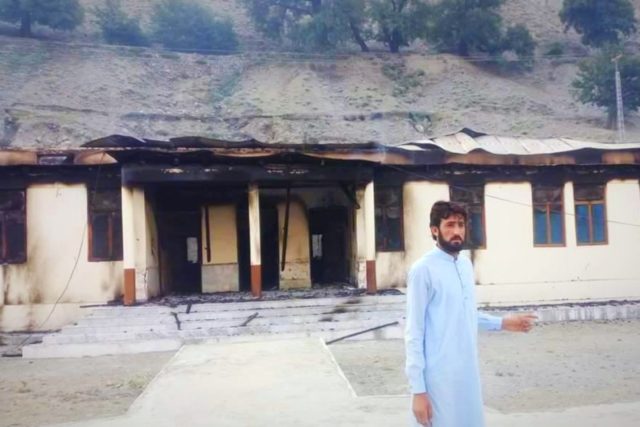
Recent Wave of Terrorism in Pakistan’s Gilgit-Baltistan Region
Publication: Terrorism Monitor Volume: 16 Issue: 21
By:

The recent wave of terrorist attacks on girls’ schools in the northern Gilgit-Baltistan region of Pakistan has once again highlighted the fact that no region of Pakistan is safe from terrorism and militancy. The mountainous Gilgit-Baltistan region previously remained sheltered from terrorism in mainland Pakistan. The region is a tourism hub due to its picturesque beauty and low-crime environment. Though economically struggling, the region has a high literacy rate in comparison with other provinces of Pakistan.
Shia-Sunni sectarian strife has been ongoing in the region for quite some time, but the communities have rarely adopted violent tactics. The most significant terrorist incident in the region took place in June 2013, when members of the Tehreek-e-Taliban Pakistan (TTP) killed nine foreign tourists (hikers from the United States, China, Slovakia, Lithuania, Ukraine and Nepal), their guide and chef (Express Tribune, June 23, 2013). The hikers were at the base camp of Nanga Parbat Mountain when the terrorists attacked. The incident was disastrous for Pakistan’s tourism industry, which suffered significantly after the incident. Just two months after the attack, the team investigating the case was ambushed in Chilas town. The district superintendent of police and two military officers were killed.
A New Wave of Terrorism
The Nanga Parbat terrorist attack was a watershed incident for Gilgit-Baltistan and underscored the region’s vulnerability to future attacks. The current wave of terrorist attacks began on August 3 when, in a single night, suspected TTP militants simultaneously torched and bombed 12 girls’ schools in Chilas district, 130 kilometers from the provincial headquarters in the city of Gilgit (Geo News, August 3). All of the targeted schools suffered significant damage as the terrorists burned the properties and planted explosive devices. Another girl’s school was torched in the Diamer district on August 5 while the police were still investigating the previous cases (Nation, August 5). On August 11, militants opened fire on the residence of Deputy Commissioner of Diamer district, Dildar Malik, and burned a bulldozer at a development project site in Khambri Village. Militants also conducted an attack on a police checkpoint near Kargah Nala, 30 kilometers from Gilgit city, which resulted in the death of three police officers and one militant. The militant killed was recognized as Commander Khalil of the TTP. He had a bounty of 3 million rupees ($22,441.46) for his alleged involvement in the planning and execution of the Nanga Parbat attack and subsequent killing of three of the officers investigating that attack (Dawn, August 11).
The spree of terrorist attacks was seemingly disrupted when police foiled a bid to blow up a girls’ school in Ghizer district. Police subsequently arrested 13 Islamist militants and seized a cache of weapons and explosives. The militants belonged to a local religious seminary adhering to militant Islamist views. A local cleric, known as Inayatullah, who ran the same seminary was also arrested by the police (Dawn, Aug 26). Authorities also stated that those arrested had confessed to other failed plots to attack Prince Kareem Agha Khan and former governor, Pir Karam Ali Shah.
The terrorist attacks showcased the resurgence of the TTP in the Gilgit-Baltistan region. The wave of attacks clearly demonstrated the group’s recruitment as well as its ability and willingness to conduct a variety of attacks. In the past, aside from the Nanga Parbat attack, terrorist attacks had primarily focused on destroying girls’ schools in the region. Nine girls’ schools were destroyed in 2004 and four were torched and blown up in 2011. The current wave of attacks, however, display a higher intensity and frequency of terrorist attacks, suggesting a more concerted effort and increased planning compared to the past cases (Geo TV, Aug 3). Despite the local police and security forces’ claims of arresting all the suspects and killing at least one terrorist, it is likely that the network still exists and more needs to be done to prevent the resurgence of Islamist militancy in the region.
Conclusion
The re-surfacing of Islamist terrorism in the northern Gilgit-Baltistan region of Pakistan is a matter of grave concern for Pakistan, which benefits from tourism in the region. The region is in close proximity to the restive Chinese Xinjiang Autonomous Region and also borders the Indian State of Jammu and Kashmir. The region is overwhelmingly Shia and has experienced sectarian strife in the past that militants might attempt to exploit. The recent growth of Islamist militancy in the region is a cautionary sign. According to one estimate, a total of 1,500 girls’ schools have been burned down or blown up by Islamist terrorists during the last 10 years (Nation, August 4). Tribal areas of Pakistan—including in Khyber-Pakhtunkhwa province and Gilgit-Baltistan—have experienced burnings of girls’ schools in the past, and often times such incidents have preceded a broader, full-fledged Islamist insurgency. Given past trends, security policymakers in Pakistan should take immediate action and frame policy measures to curb militancy in the region before it escalates further.




